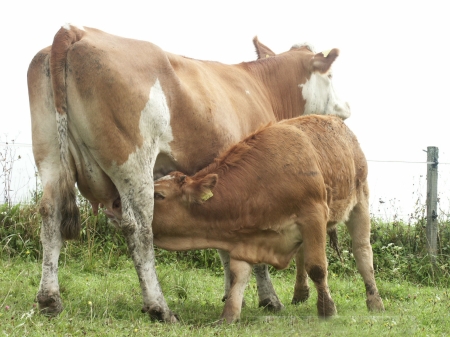It can also be expected that the production of adjusters for fattening will become more important in the future. Increasingly, these feeders will also be produced by extensive farming operations (extensive pasture, low labor input, early weaning date, etc.). The research project is therefore intended to address questions about extensive suckler cow farming using moderate forage quality. Feed quality influences feed and nutrient intake and thus milk production, body condition, physiology as well as animal health, fertility and calf development and ultimately the profitability and nutrient cycle of suckler cow farms. Moderate basic feed quality leads to a significant and long-lasting nutrient deficiency in suckler cows during the nursing period and a corresponding decrease in body condition. Only if the weaning date is adapted to the feed quality (the lower the quality, the earlier) can the body reserves be “filled up” again until the new calving, so that no negative influence on animal health and fertility is caused.
As part of this project, an exact experiment is being carried out with suckler cows of the Fleckvieh breed at the LFZ Raumberg-Gumpenstein. The effects on feed and nutrient intake, milk production and body condition development as well as nutrient supply and excretion, physiological parameters, animal and udder health, fertility, the development of young cattle up to weaning, fattening performance in the finishing phase, meat quality and economic efficiency are tested ecologically relevant aspects (nutrient flows). In order to also be able to work on the effect of the weaning date, the young cattle are weaned from the cows at 180 or 270 days.
In addition, data from an extensive farm with around 170 suckler cows ("Krutzler KEG" - Lafnitztal in A-7411 Loipersdorf in Burgenland) are also evaluated with regard to animal health, fertility and performance.
The project deals with the possibilities and effects as well as the limits of extensification on suckler cow farms. In contrast to the current "more intensive" production of young cattle (young cattle - slaughter with 300 - 400 kg live weight) or feeders (sale to the fattening farm with 300 - 350 kg live weight), the present project aims to investigate the effects of extensive feeding conditions on animal and management factors become.
The aim is to test the hypothesis as to whether, under extensive conditions, an earlier weaning date can improve the health and fertility of suckler cows.
Table: Possibilities in keeping suckler cows
|
Adjuster |
Young beef |
breed |
||
|
extensive |
more intense |
more intense |
more intense |
|
|
Weaning, months |
5 - 7 |
6 - 9 |
8 - 11 |
6 - 9 |
|
Sales, months |
4 - 6 |
6 - 10 |
9 - 12 |
16 - 24 |
|
feed quality |
moderate |
good |
good |
good - very good |
|
Organic possible |
Yes |
Yes |
Yes |
Yes |
The results of the experiment are intended to form the basis for advisory recommendations for extensive suckler cow farms. The aim is to provide basic data that leads to adapted management and animal, environmental and product-friendly feeding of suckler cows and their young cattle.
- In addition to the basic results on feed intake and nutrient supply, the present research project is primarily intended to investigate the effects of extensive suckler cow farming on physiological parameters, animal health and fertility.
- The economic effects are evaluated with the help of a business analysis.
- The ecological impacts are calculated using an operating model.
Exact test at the HBLFA Raumberg-Gumpenstein
8 Simmental cows with a first calving age of approx. 26 to 30 months will be put into the experiment. The calves are inseminated with the sire breed Limousin (Legionnaire). In subsequent lactations, the cows are uniformly assigned Charolais (ancestor) as the sire breed.
The experiment with suckler cows extends over 3 complete suckling and dry periods in order to be able to assess the possible long-term effects on animal health and fertility associated with the question.
The suckler cows and young cattle receive free consumption of late-harvested grassland feed (mid to end of flowering, energy concentration 4.8 to 5.2 MJ NEL) from a double-cut permanent grassland area (grass silage - 1st growth; hay - 2nd growth). An additional concentrated feed supplement is not provided. The permanent grassland area is fertilized with manure from the suckler cow herd.
The feed intake of cows and young cattle is recorded daily on an individual animal basis (Calan system). The mother cows and young cattle are supplied with minerals based on their needs using mineral mixtures and cattle salt. The area yield of the extensively used permanent grassland meadow is recorded in order to be able to answer ecological and economic questions.
When the young cattle are fattened out, they are fed with corn silage, hay and concentrated feed as well as minerals and vitamins.
The following parameters are examined:
- Nutrient contents (weeds, structural substances, minerals and trace elements, energy determination using the cellulase method) of the grass silage as well as the hay and corn silage
- Milk production (suckling period 180 or 270 days)
- Physiological parameters (milk progesterone, urea, crea, Tbil, GOT, GGT, ß-HBSre, FFS, Ca, P, Mg, Gluc, insulin)
- Bacteriological milk sample analysis
- Udder health
- Fertility and health parameters
- Live mass, BCS and fattening performance
- Fattening and slaughter performance as well as meat quality
Live mass, slaughter mass, EUROP classification, slaughtering, cutting of the right half of the slaughter to determine the tissue proportions (meat proportion, fat sections, bones, nutrient content of the back muscle, dry matter, total fat, crude protein, crude ash (Mld), shear force measurements - back muscle, Meat (back muscle) and fat color (surface fat breast area), tasting of the unseasoned meat (tenderness, juiciness, taste, overall impression), loss of dripping juice (back muscle), loss of cooking juice (back muscle), pH measurement (back muscle) - Nutrient supply and nutrient cycling
- Economic calculations
Further information on project management can be found in the database for research and sustainable development (Dafne) -> Link







